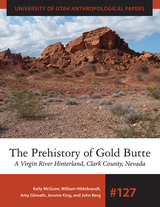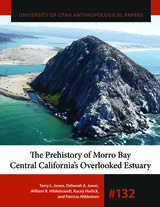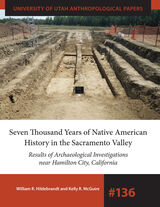3 books by Hildebrandt, William R.

The Prehistory of Gold Butte
A Virgin River Hinterland, Clark County, Nevada
Kelly R McGuire
University of Utah Press, 2014
University of Utah Anthropological Paper No. 127
The Prehistory of Gold Butte uses a theoretical perspective rooted in human behavior ecology and other foraging models to present the results of one of the largest and most comprehensive archaeological investigations ever undertaken in southern Nevada, involving the systematic survey of more than 31,000 acres, the documentation of more than 377 sites, and the excavation of nine prehistoric sites. Gold Butte—at the crossroads of the Mojave Desert, the Great Basin, and the Colorado Plateau in southern Nevada—has a 12,000-year record of human occupation with archaeological elements that can be traced to all three culture zones.
The Prehistory of Gold Butte uses a theoretical perspective rooted in human behavior ecology and other foraging models to present the results of one of the largest and most comprehensive archaeological investigations ever undertaken in southern Nevada, involving the systematic survey of more than 31,000 acres, the documentation of more than 377 sites, and the excavation of nine prehistoric sites. Gold Butte—at the crossroads of the Mojave Desert, the Great Basin, and the Colorado Plateau in southern Nevada—has a 12,000-year record of human occupation with archaeological elements that can be traced to all three culture zones.
Dramatic developments occurred in this area of the Desert West. Farmers suddenly appeared in the Virgin River basin about 1,600 years ago. At such iconic sites as Lost City, Main Ridge, and Mesa House, full village and agricultural life developed over the span of a few hundred years only to completely vanish by AD 1250 after a series of droughts and other cultural disruptions. The Patayan held sway for several hundred years, between AD 1100 and 1500, but didn’t advance much beyond the Colorado River corridor. Finally, the Southern Paiute arrived and occupied not only the Virgin River basin and Gold Butte but much of the northwestern quadrant of the Southwest from at least the time of historic contact (AD 1500) to the present.
This mix of cultures illustrates historical contingency, inplace development, and external relationships that should be expected along a boundary area such as Gold Butte. By looking at hinterlands adjoining the prehistoric settlements that clustered along the Virgin River corridor before, during, and after the Puebloan period, the authors suggest that changes in settlement- subsistence and lifeways at core settlements along the riverine corridor have corresponding effects on the character and intensity of hinterland occupation.
[more]

The Prehistory of Morro Bay
Central California's Overlooked Estuary
Edited by Terry L. Jones, Deborah A. Jones, William R. Hildebrandt, Kacey Hadick, and Patricia Mikkelsen
University of Utah Press, 2019
Morro Bay is one of more than thirty major estuaries where prehistoric people thrived along the California coast, yet for much of the twentieth century these systems were deemed insignificant within the broader outline of New World prehistory. Recent research, however, has shown that estuaries were magnets for human occupation as early as 10,000 years ago. This book combines archaeological data from large-scale excavations completed between 2003 and 2014 with other studies from Morro Bay to reveal a heretofore overlooked yet remarkable history of cultural change and adaptation. Over the last 8,000 years, as the bay evolved toward its current configuration, inhabitants endured earthquake and drought, regularly adjusting their settlement practices but continuing to fish and collect shellfish. Their populations slowly grew against a backdrop of extreme resource diversity and diachronic habitat variation, ultimately leaving behind evidence of a unique human-estuary ecological saga.
[more]

Seven Thousand Years of Native American History in the Sacramento Valley
Results of Archaeological Investigations near Hamilton City, California
William R. Hildebrandt and Kelly R. McGuire
University of Utah Press, 2022
The Sacramento Valley of northern California is a rich, diverse environment that supported some of the densest populations of nonagricultural people in the world. Periodic flooding, however, has buried much of the valley’s deep cultural history under alluvium. This volume shares the discovery of four buried archaeological sites, including one dating to 7,000 years ago, filled with a diversified assemblage of artifacts and a rich assortment of food remains. Stone net sinkers and associated fish bones represent the oldest fishery ever documented in the interior of California, while such items as marine shell beads, exotic obsidian, and newly recovered charmstones in California provide evidence for long-distance trade networks. in California provide evidence for long-distance trade networks.
The other three sites date between 4000 and 300 years ago and reflect increasing human population density, technological innovation, and the rise of sedentism and territoriality. This historical sequence culminated in findings from a 400- to 300-year-old house complex probably occupied by the Mechoopda Indian Tribe, who collaborated with the authors throughout the project.
The other three sites date between 4000 and 300 years ago and reflect increasing human population density, technological innovation, and the rise of sedentism and territoriality. This historical sequence culminated in findings from a 400- to 300-year-old house complex probably occupied by the Mechoopda Indian Tribe, who collaborated with the authors throughout the project.
[more]
READERS
Browse our collection.
PUBLISHERS
See BiblioVault's publisher services.
STUDENT SERVICES
Files for college accessibility offices.
UChicago Accessibility Resources
home | accessibility | search | about | contact us
BiblioVault ® 2001 - 2024
The University of Chicago Press









